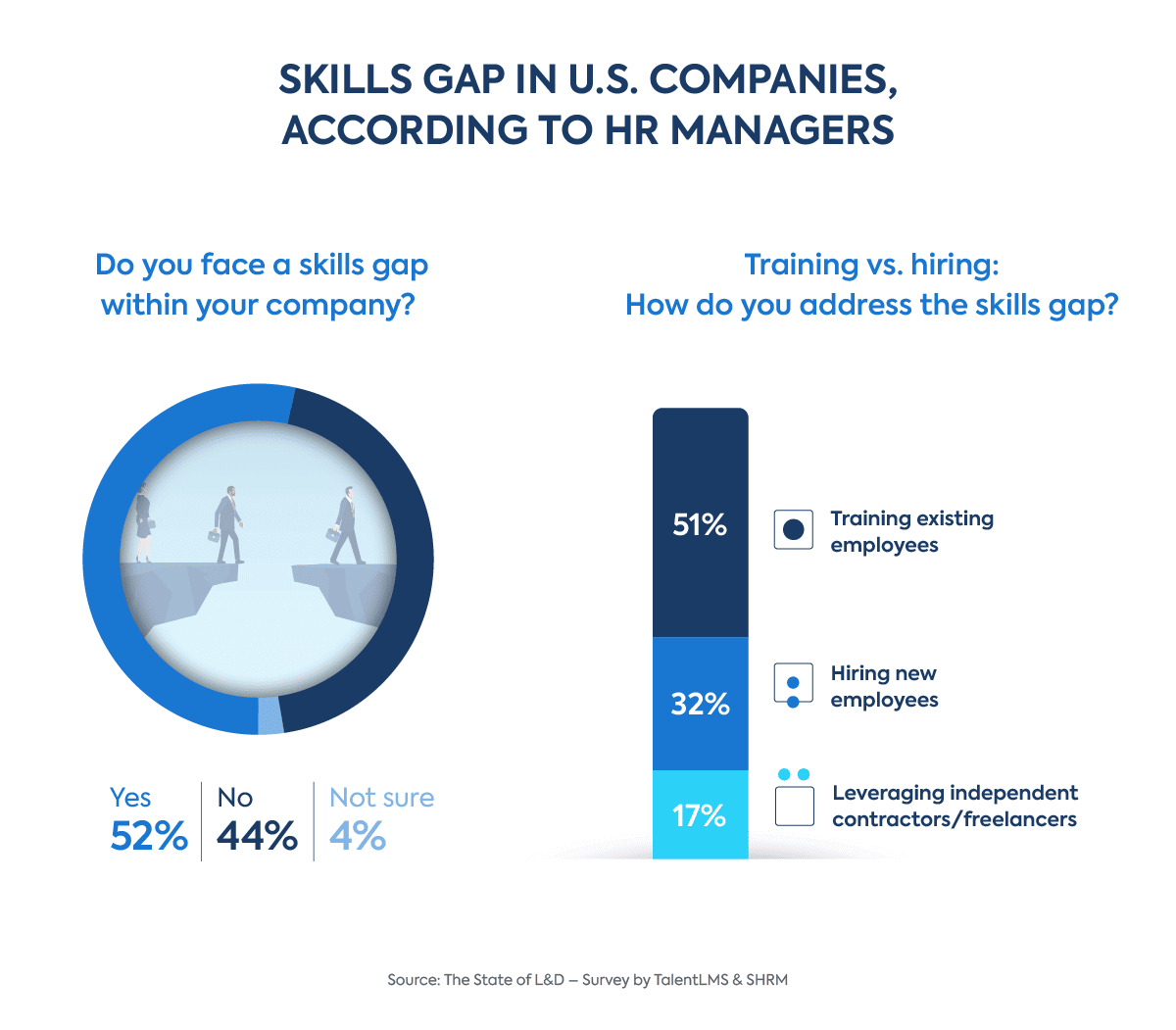You put a lot of work into preparing your L&D budget. From tracking KPIs to following trends to forecasting business needs, it’s an active process that requires data and insight. But budgeting isn’t just a one-off event you do to kick off your year.
Priorities change and trends evolve, and you need the flexibility to keep up. Budgeting wisely means re-evaluating regularly to ensure you’re making the best use of your resources. And mid-year is a good time to revisit your spending and decide whether to make adjustments as you prepare for future investments.
It’s a heavy task, but you don’t have to prepare a new L&D budget from scratch. You just need to know where to focus and how to look for areas for improvement. In this article, we’ll talk about how the pandemic affected training budgets and priorities. We’ll also discuss how you can help senior leadership understand the importance of investing in employee development. Finally, we’ll cover current L&D trends and how you should prioritize spending for 2022.
Training budgets amidst the pandemic
Research we conducted in partnership with the Society for Human Resources Management (SHRM) at the end of last year reveals how the pandemic shifted priorities and how that impacted L&D budgets.
The majority of HR leaders (57%) say their L&D budgets increased following the outbreak of the pandemic. And an even higher percentage (67%) said they planned to raise their budgets for 2022. Clearly, employee development has been a priority.
So how did companies put their extra budget to use during this time of transition? Here are two significant investments they made.
1. Virtual and online learning solutions
Despite the initial decline in L&D spending as companies were forced to abandon traditional in-person training, the demand for digital solutions increased. Companies began investing in online platforms to train their remote learners.
The pandemic sped up the digital transformation already at play in training. As the dust settled from the initial switch to remote work, HR professionals began planning ways to fit training into this new work model.
At the end of 2020, 79% of L&D pros reported that they planned to spend more money on online learning going forward, while 73% said they’d spend less on traditional instructor-led training. Money was earmarked for online learning solutions, including cloud-based platforms and self-paced training modules.
2. Urgent skills and knowledge needs
Many organizations decided to continue with work-from-home and hybrid work models after the initial move to remote work. The new arrangements presented an immediate need for training people to thrive in these new work environments.
For example, companies are now investing in cloud tools and need to train their teams on how to use them. Or, they double down on soft skills training so people can better communicate even from afar.
Train your teams anywhere, anytime, with TalentLMS
The training platform that users consistently rank #1.
Easy to set up, easy to use, easy to customize.
Why you should think of training as an investment
Many companies increased their L&D budgets during the pandemic, but 52% of HR managers still report facing resistance when seeking budget approval. Despite increased support for L&D, leadership in many organizations still hesitates when it comes to funding.
The problem, according to 54% of the HR professionals surveyed, stems from the fact that leadership sees L&D as a cost and not as an investment.
If you face resistance in your organization, consider sharing the following reasons funding employee development is in your best interest.
- Retaining employees. Over three-fourths of employees surveyed (76%) said they’re more likely to stick with a company that provides continuous opportunities for training. Employees who receive training report being more engaged in and satisfied with their jobs. And happy employees mean less turnover for you.
- Boosting profits. Companies that provide employee development report a 24% higher profit margin compared to those that don’t.
- Attracting top talent. Eighty percent of leaders polled said offering training helped them attract top candidates when hiring. In today’s competitive market, employees see training as a benefit. Offering a robust employee development program will help you stand out as an employer and build a strong brand with potential new hires.
Help leadership see how training is an investment by giving them the facts. You can strengthen your position by being prepared with a solid plan on how you’ll put the budget to good use.
Where to spend your L&D budget in 2022—and beyond
To get the most out of your budget, you must be strategic about your spending. Look at current learning and development trends and needs to help you prioritize your expenditures this year.
Here are four areas to focus on:
1. Upskilling and reskilling
Currently, many companies are looking to fill skill gaps among their employees. According to our research, over half of HR managers say their workforce is facing a skill gap. And again, over half of the companies surveyed said they plan to fill the gaps by training existing employees.

As a solution, nearly 60% of leaders said they’d offer upskilling training in the coming year, and 55% plan to support reskilling. A third of the companies surveyed already had upskilling and reskilling training programs in place.
2. Virtual, hybrid, and on-demand training
Many organizations are earmarking more budget for online training solutions and less for traditional instructor-led courses. With more remote and hybrid employees, companies are looking for ways to meet the needs of all their employees, wherever they’re located.
That means replacing much, if not all, traditional classroom learning with online, self-paced training. Companies are investing in cloud-based LMS options that support remote learners and on-site employees alike.
Letting people learn at their own pace when and where it suits them is not only more convenient for learners. It also promotes better learning by removing time constraints from already busy schedules. Employees can focus on the content more when it’s broken into easily digested chunks and they’re able to access it in their downtime.
Meet TalentLibrary™
A growing collection of ready-made courses
that last no longer than 15 minutes.
![]()

3. Diversity, equity, and inclusion training
With an increasingly diverse workforce, companies are recognizing the value of creating an inclusive and safe workplace for all. Research shows that diversity in the workplace leads to increased profitability. It also boosts creativity, which leads to stronger problem-solving.
Today, 40% of companies offer DE&I training. And one-fourth of employees say it’s important to them that their organization offers it.
Building your workforce’s understanding of inclusion will help you harness the power of diversity. It will ensure your workplace is a safe space where all voices are heard.
4. Personalized learning
Learners process and retain information better when training is geared toward their individual strengths and circumstances. And 93% of companies support the idea that personalized training improves productivity for both the individual and the organization as a whole.
As proof of how strongly they feel, over 80% of companies say they’re focused on personalizing learning by adopting new learning processes.
You can capitalize on this knowledge by using your budget for systems that support personalization. This might mean investing in a system that uses data from the hiring process to automatically assign the right onboarding training courses. It could mean employing a system that uses AI to analyze results and performance to identify specific learning needs. Or, you can go for a system that includes ready-made courses, so people can choose what they learn next based on on their career goals and professional interests.
Putting people first is the key to successful L&D
Whatever trends you’ve supported this year or course corrections you’re looking at now, it’s important to remember that people are at the heart of your efforts. Your overall objective is to support your employees and help them succeed in their careers.
When you prioritize employee development, you ensure your own organization’s success. From retention to stronger profit margins, happy and successful employees will support all your most important company goals.
| Tags: Employee Training



